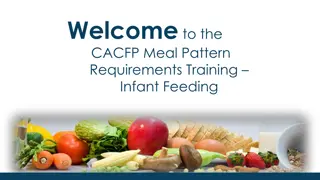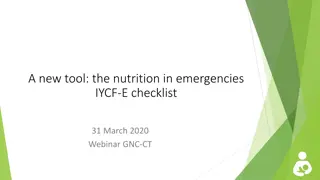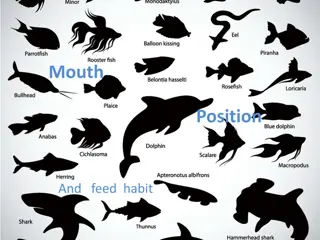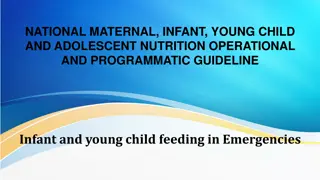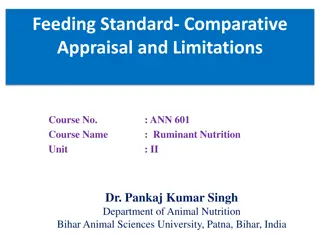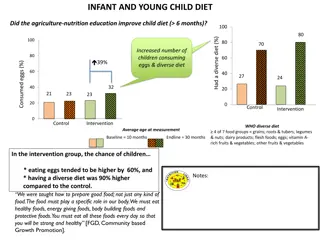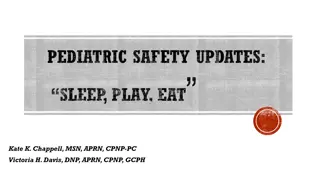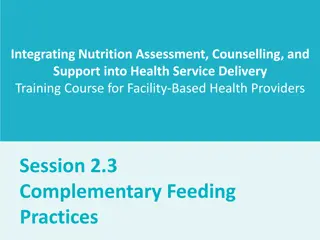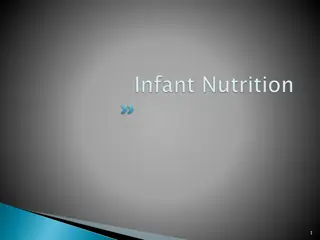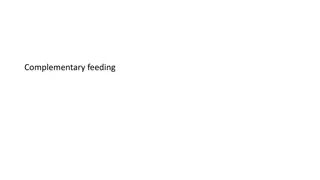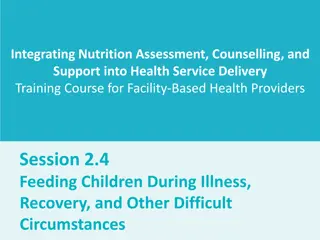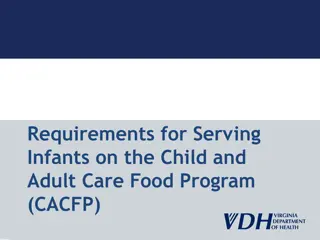Global Impact of Infant and Young Child Feeding (IYCF) Strategies
Global strategies like Infant and Young Child Feeding (IYCF) developed by WHO and UNICEF aim to address the high mortality rates among children under 5 due to malnutrition. The strategies emphasize the importance of appropriate feeding practices during pregnancy, lactation, and early childhood to combat micronutrient deficiencies and various forms of malnutrition. With millions of child deaths attributed to inadequate nutrition, initiatives such as the Baby-Friendly Way promote successful breastfeeding practices to improve health outcomes for both mothers and infants.
Download Presentation

Please find below an Image/Link to download the presentation.
The content on the website is provided AS IS for your information and personal use only. It may not be sold, licensed, or shared on other websites without obtaining consent from the author. Download presentation by click this link. If you encounter any issues during the download, it is possible that the publisher has removed the file from their server.
E N D
Presentation Transcript
Infant and Young Child Feeding (IYCF) Abdul Rehman Pirzado MBBS,DCH,MSPH
Infant and Young Child Feeding (IYCF) Global strategy developed by WHO and UNICEF to revitalize world attention on the impact that feeding practices have on infants and young children Malnutrition has been responsible, directly or indirectly, for over 50% of the 10.9 million deaths annually among children under5 years of age Over two-thirds of these deaths occur in the first year of life
Global situation 7.6 million children U5 years die /year 2.6 million (35%) ---- malnutrition---1/3rd(10%) of these deaths are due to micronutrient deficiencies 170 million (27% of all children globally )--- stunted (low Ht/age),100 million of total in Asia 100 million --- under weight (Low wt/age)---19% of child death 60 million ---wasted (low wt/ht) 20 million/yr ---LBW (<2.5 kg) Save the Children-2012
Malnutrition in Pakistan (NNS 2011) In Pakistan, the nutritional status of children under 5 years of age is extremely poor. Child Malnutrition rates in Pakistan is significantly high. Types of Malnutrition Anemia --- 61.9% Stunting --- 43.7% Vitamin A deficiency --- 54% Under weight --- 31.5% Vitamin D deficiency --- 40% Wasting --- 15.1% Zinc deficiency --- 39.2% Micronutrient deficiency
Appropriate diet during pregnancy & lactation During Pregnancy During Lactation Women does not need more food during pregnancy Three meals each day plus two extra small meals or snacks in between meals to sustain energy and better take care of child 3 meals each day plus one extra small meal or snack in between meals Peas, lentils , beans, oil, green vegetables or fruit and meat Never stay thirsty; use of juice, soups etc. should be increased
The Baby-Friendly Way TEN STEPS TO SUCCESSFUL BREASTFEEDING Every facility providing maternity services and care for newborn infants should: 1. Have a written breastfeeding policy that is routinely communicated to all health care staff. 2. Train all health care staff in skills necessary to implement this policy. 3. Inform all pregnant women about the benefits and management of breastfeeding. 4. Help mothers initiate breastfeeding within an half hour of birth. 5. Show mothers how to breastfeed, and how to maintain lactation even if they should be separated from their infants.
The Baby-Friendly Way TEN STEPS TO SUCCESSFUL BREASTFEEDING Every facility providing maternity services and care for newborn infants should: 6. Give newborn infants no food or drink other than breast milk unless medically indicated. 7. Practise rooming in allow mothers and infants to remain together 24 hours a day. 8. Encourage breastfeeding on demand. 9. Give no artificial teats or pacifiers (also called dummies or soothers) to breastfeeding infants. 10. Foster the establishment of breastfeeding support groups and refer mothers to them on discharge from the hospital or clinic.
Good position & Attachment Baby head & body in line Baby held close to mothers body Baby whole body supported Baby approaches breast nose to nipple. More areola visible above baby s mouth than below Baby s mouth wide open Lower lip turned outwards Chin close to breast
Nutrition: Food Groups Staple Food: Wheat Rice Corn Millets Protein: Meat Fish Egg Bean Minerals and Vitamins: Fruits Green leafs Vegetables Calories: Oils Fat Honey
Recommended Complementary Feeding Practices Age Frequency Amount of food Texture/ thickness Varity 2-3 TSF upto cup(250ml) Thick porridge Breastfeed + Staple foods 6-8 months 2 3 times 4 times food & snacks to 1 cup(250ml) Breastfeed + Staple foods Meshed food 9-11 months 5 times food & snacks Family food sliced Breastfeed Staple foods 12-23 months 1 - 2cup(250ml) If baby is not breastfed Add 1 to 2 extra servings Add 1-2 cups of milk daily Be patient and actively encourage baby to eat Feed you baby in a clean cup with spoon Never use bottle for feeding Wash your hands before feeding with soap and water before preparing food, eating and feeding your child
Ten Key Messages Breastfeeding for two years or longer helps a child to develop and grow strong and healthy Starting other foods in addition to breast milk at 6 completed months helps a child to grow well Foods that are thick enough to stay in the spoon give more energy to the child Animal-source foods are especially good for children, to help them grow strong and lively Peas, beans, lentils, nuts and seeds are also good for children Dark-green leaves and yellow-colored fruits and vegetables help a child to have healthy eyes and fewer infections
Ten Key Messages A growing child 6 8 months needs 2 3 meals a day A growing child 9 24 months needs three to four meals a day Plus additional 1 2 snacks if the child is hungry: Give a variety of foods A growing child needs increasing amounts of food A young child needs to learn to eat: encourage and give help with lots of patience Encourage children to drink and eat during illness and provide extra food after illness to help them recover quickly
Three step counseling Help you to counsel with mothers for infant & young child feeding Step 1 ---- Assess ; Ask , Listen & observe--- Assess age appropriate feeding practices & health of child & mother Step 2 ---- Analyze ; identify difficulties & prioritize the difficulties if more then than 1 difficulty, praise mother Step 3 ---- Act ; discuss , suggest small amount of relevant information, give option regarding feeding difficulty & help mother to select one option . Additional Support --- Refer to health facility, IYCF support group in community, Health worker Thank the mother ,Set next meeting
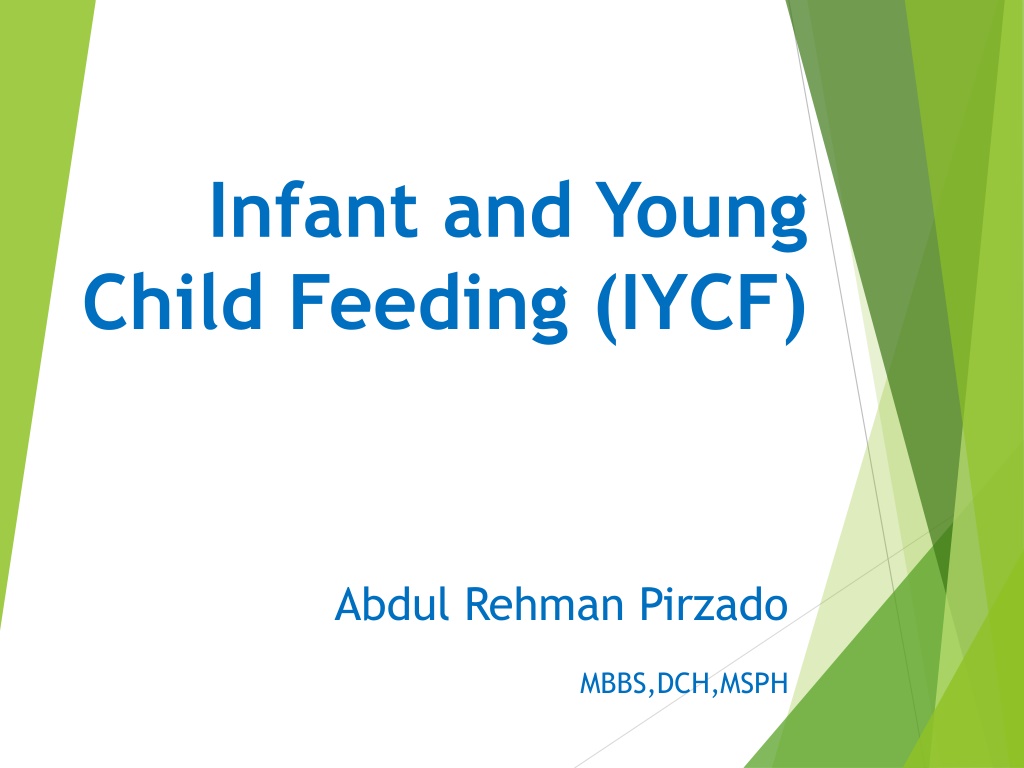
 undefined
undefined




